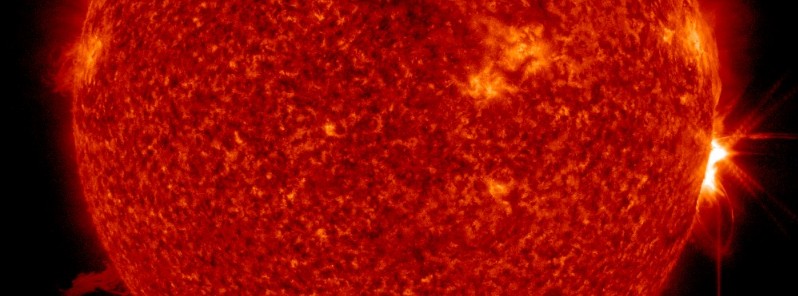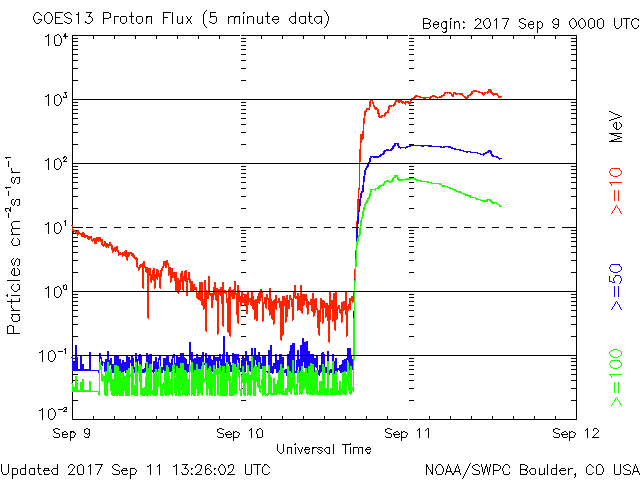Glancing blow expected from CME produced by major X8.2 solar flare

A major X8.2 solar flare that erupted at 16:06 UTC on September 10, 2017 from Region 2673, produced a powerful asymmetric full halo Coronal Mass Ejection (CME) and it appears one part of it is heading toward Earth. A glancing blow is expected late on September 13. The CME impact might be exacerbated by the influence of a positive polarity coronal hole high speed stream. A G2 – Moderate geomagnetic storm watch is in effect for September 13.
Over the past 24 hours, solar activity was at high levels due to an X8.2 solar flare (R3 – Strong radio blackout) produced by Region 2673, now located behind the west limb and starting its ~14 day transit through the Sun's far side.
This was the second strongest solar flare of the current solar cycle (Solar Cycle 24). The largest was X9.3 produced by the same active region on September 6, 2017. Solar Cycle 24 began in December 2008. It is the 24th solar cycle since 1755, when extensive recording of solar sunspot activity began.
Associated with the X8.2 event was a 1,900 sfu Tenflare, a Type IV and II radio sweep (estimated velocity of 928 km/h), and an asymmetric full halo CME signature.
"A magnetic crochet was observed on solar-facing magnetometers during the X8 flare as well as an EIT wave propagating across the solar disk in SDO/EUV 193 imagery beginning at 15:57 UTC on September 10," SPWC said.
Read more: 4th X-class flare: X8.2 erupts from Region 2673, second strongest of the cycle (published September 10 and updated September 11)
CME produced by X8.2 solar flare and a strong solar radiation storm as it hits ESA/NASA SOHO/LASCO C3 coronagraph
"Due to the source region's location at the time of the eruption, approximately 3 degrees around the W limb, a vast majority of the ejecta is not directed at Earth. After detailed analysis it has been determined that a possibility exists for a glancing blow enhancement late September 13 as a result of this large solar event," the center said.
In addition, the greater than 2 MeV electron flux was at moderate to high levels over the past 24 hours with a maximum flux of 7,875 pfu at 15:05 UTC on September 10. The greater than 10 MeV proton flux ranged from S1 – S3 (Minor – Strong) solar radiation storm levels.
The proton flux reached the S1 threshold at 16:45 UTC on September 10, the S2 threshold at 17:05 UTC, the S3 threshold at 18:40 UTC, and continued to increase to a peak flux of 1,440 pfu at 22:50 UTC.
Current 10 MeV proton flux (12:30 UTC, September 11) values are above the S3 level.

As reported by Dr. Tamitha Skov, a credentialed Space Meteorologist, due to the ongoing S3-level radiation storm, NASA model has an active alert for aircrew and prenatal [pregnant] passengers on transcontinental flights now.
There are, on average, just ten S3 – Strong space radiation storms per one solar cycle (~11 years).
Potential impacts include:
- Radiation – Passengers and crew in high latitude, high altitude flights may experience increasing radiation exposures. Astronauts on EVA (extra-vehicular activity) are exposed to elevated radiation levels.
- Spacecraft – Single-event upsets to satellite operations, noise in imaging systems, and slight reduction of efficiency in solar panels are likely.
- Radio – Degraded or episodically blacked-out polar HF (high frequency) radio propagation.
Strong solar radiation storm hits ESA/NASA SOHO/LASCO C2 coronagraph
Read more: S3 – Strong solar radiation storm in progress, active alert for aircrews and pregnant passengers (published September 11)
Over the next 3 days, the greater than 2 MeV electron flux is expected to be at moderate to high levels. The greater than 10 MeV proton flux enhancement is expected to continue, with S1 – S2 (Minor – Moderate) levels likely on September 12 and 13.
Solar wind parameters, as measured by the DSCOVR spacecraft, suggested a weak influence from a negative polarity coronal hole high speed stream (CH HSS) over the past 24 hours. Wind speed was steady at approximately 550 km/s until 22:00 UTC on September 10 when it began to increase, reaching a maximum of near 660 km/s near 00:00 UTC on September 11. The total field (Bt) ranged between 1 and 7 nT while the Bz component dropped to -5 nT for a brief time. Phi angle was negative until approximately 08:00 UTC on September 11 when it switched orientation to a positive sector.
An enhancement in the solar wind parameters is expected late September 12 in a response to the onset of a recurrent, positive polarity CH HSS. A glancing blow enhancement is possible late September 13 from the September 10th CME.
Over the past 24 hours, the Earth's magnetic field was at quiet to unsettled levels with an isolated period of active conditions as a result of weak CH HSS influence. It is expected to be at quiet to unsettled levels, with isolated periods of active conditions possible on September 11 due to influence from a negative polarity CH HSS.
Active levels are likely on September 13 under the combined influence of the CH HSS and possible glancing blow effects from the September 10th CME, SWPC said in their Forecast Discussion issued 12:30 UTC today.
Featured image: X8.2 solar flare on September 10, 2017. Credit: NASA/SDO AIA 304. Acquired: 16:28 UTC

Commenting rules and guidelines
We value the thoughts and opinions of our readers and welcome healthy discussions on our website. In order to maintain a respectful and positive community, we ask that all commenters follow these rules.